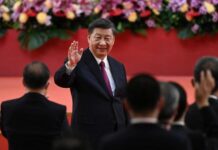(TibetanReview.net, Jul29’21) – The recent visit to Tibet by Xi Jinping, the first by the top Chinese leader in three decades, was designed to send a message to the US, India and the Dalai Lama, reported the scmp.com Jul 28, citing observers. His visit to Drepung, a leading Buddhist monastery, may also have been a way to highlight Beijing’s grip on the region, the report added. But more than anything else, the trip was a troubling message to India, analysts have indicated.
The visit was a way for Beijing to flex its muscles and send a clear message about its dominance of the region, the report cited analysts as saying.
Xi’s latest policy edict on Tibet – summarised in eight Chinese characters that translate as “stability, development, ecology and border-area consolidation” – and the stage-management of the event were meant to send a clear message to domestic audiences and to India and the Dalai Lama, the report said.
The official reason for Xi’s three-day trip, which concluded on Jul 23, was to highlight the 70th anniversary of what Beijing calls the peaceful liberation of Tibet, generally referring to the beginning of the People’s Liberation Army’s stationing in the region in 1951, following a milestone, one-sided “agreement” between “the central government” and “the local administration in Lhasa” earlier that year.
Xi’s first two priorities – stability and development – echo the policies announced by Jiang Zemin on a 1990 visit to Tibet, the last visit by a top leader that came months after a series of major protests against Chinese rule, the report noted.
Xi began his trip with Nyingchi (Tibetan: Nyingtri), site of a major Chinese military base in southeastern Tibet. The report cited Robert Barnett, a professorial research associate at the School of African and Oriental Studies in London, as saying his choice may be a “troubling sign” for India, as it is the closest population centre to the contested territory of Arunachal Pradesh, which is more important for India than the unpopulated Chinese-held Indian territory of Aksai Chin.
The report cited Raffaello Pantucci, a senior fellow at the S Rajaratnam School of International Studies at Singapore, as saying Xi’s priorities all “illustrate the centrality of the border question to how Beijing looks at Tibet”.
“It’s a clear reminder to India of the importance of Tibet and these borders to China – something that China is keen to clarify, in part in response to continuing border tensions, but also India’s clear and increasing outreach to the United States.”
Significantly, Xi’s entourage to Tibet included Zhang Youxia, a deputy chairman of the Central Military Commission and a member of the 25-strong Politburo. The presence of such a high-ranking military commander is relatively rare on domestic visits and the report cited Pantucci as saying it helped reinforce the message that Chinese soldiers on the front line are operating with the approval of the party’s leadership.
The report also cited Barnett as saying Xi’s visit to major infrastructure projects along the border sent a signal to India that China was pushing ahead with its border development – an area in which New Delhi has lagged.
According to Barnett, Xi’s comments about stabilising Tibet were intended to signal that Beijing believed it was on track to achieve dominance in the Himalayas.
“This means stepping up tensions with India. When Xi addressed the troops in Lhasa on Jul 23 and instructed them to strengthen war ‘preparedness’, [it was] a signal to the military of the enormously decisive role they play through their presence along the Tibetan borders.”






